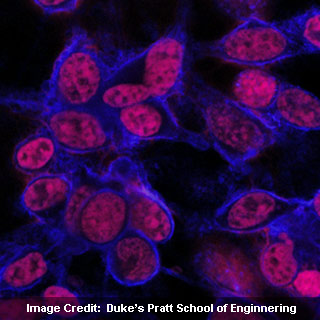
Nano-delivery systems have supposedly become progressively more striking to researchers because of their capability to capably enter the tumors. As blood vessels delivering tumors are alleged to be leakier as opposed to usual vessels, the nanoformulation could effortlessly penetrate and collect in tumor cells. This means that superior doses of the drug could be provided, thereby augmenting its cancer-killing abilities while apparently reducing the side effects linked to methodical chemotherapy.
Ashutosh Chilkoti, Theo Pilkington Professor of Biomedical Engineering at Duke’s Pratt School of Engineering, commented, “When used to deliver anti-cancer medications in our models, the new formulation has a four-fold higher maximum tolerated dose than the same drug by itself, and it induced nearly complete tumor regression after one injection. The free drug had only a modest effect in shrinking tumors or in prolonging animal survival.â€
Chilkoti added, “Just as importantly, we believe, is the novel method we developed to create these drugs. Unlike other approaches, we can produce large quantities simply and inexpensively, and we believe the new method theoretically could be used to improve the effectiveness of other existing cancer drugs.â€
The fundamental element to the novel technique is how the drug is joined to its polypeptide delivery system and whether or not a drug could be dissolved in water. The delivery system utilizes the bacterium Escherichia coli (E. coli) which has been hereditarily modified to supposedly generate a detailed artificial polypeptide called as chimeric polypeptide. Since E. coli are said to be frequently used to produce proteins, it apparently results in an effortless and dependable production plant for these detailed polypeptides with high yield.
When fastened to one of these chimeric polypeptides, the drug apparently takes on qualities that it does not have. Nearly all drugs do not dissolve in water, which supposedly restricts their capability to be taken in by cells. But being connected to a nanoparticle apparently makes the drug soluble.
Chilkoti mentioned, “When these two elements are combined in a container, they spontaneously self-assemble into a water-soluble nanoparticle. They also self-assemble consistently and reliably in a size of 50 nanometers or so that makes them ideal for cancer therapy. Since many chemotherapeutic drugs are insoluble, we believe that this new approach could work for them as well.â€
The recent trials included doxorubicin which is a frequently used agent for the treatment of cancers of the blood, breast, ovaries and other organs. The researchers inserted the mice, with tumors entrenched under their skin, with either the chimeric polypeptide-doxorubicin grouping or doxorubicin alone.
The mice treated with doxorubicin alone apparently had a standard tumor size 25 times more than those treated with the latest combination. The regular survival time for the doxorubicin-treated mice was apparently 27 days as opposed to more than 66 days for mice receiving the formulation.
The Duke researchers now intend to examine the new combination on other kinds of cancer, including tumors developing in different organs. They may also attempt merging these chimeric polypeptides with other insoluble drugs and check their efficacy against tumors.
These findings were published in the journal Nature Materials.
